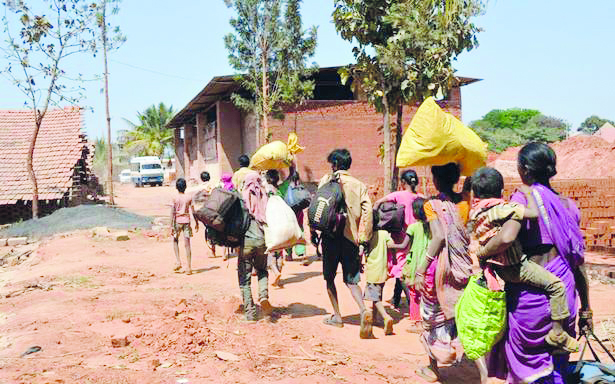Goa is abuzz with excitement as vintage bike and car owners, users, collectors and fans are decking […]

BONDED LABOUR RETURN HOME DURING COVID-19! By Vivek Menezes
In the News, May 21 -May 27 2022 May 20, 2022JOBLESS: Covid-19 not only deprived migrant labour of their jobs but they were thrown out of their rented premises and rendered homeless.
In the two years during the Covid-19 lockdown there was acute scarcity of jobs and we were back to the era of bonded labour. Since migrants (including 71,000) in Goa lost their jobs they had no choice but to go back to their home towns where it was back to working as bonded labour again!
By Vivek Menezes
On 2 May, my home state of Goa opened registration for migrants stranded by the nationwide lockdown, who wanted to cross state borders and return to their families. Huge numbers of hopeful workers lined up immediately. Less than forty-eight hours later, on the morning of 4 May, the chief minister Pramod Sawant made a startling announcement that 71,000 people had already registered for evacuation, with many more expected to follow suit. That evening, Manoj Caculo, the chairman and managing director of a family conglomerate spanning the automobile, hospitality, and real-estate businesses, wrote on his Facebook page, “This so called migrant travel is going to screw Goan Industry…They availed all our benefits and want to leave when we need to start work? Can understand some…but mass exodus??? Bad for Goan economy!!!!!”
The Caculo Group is front and centre in Goa’s commercial sphere—the only mall in the capital city, Panjim, carries the Caculo name. In May last year, Manoj Caculo was elected as president of the storied, 111-year-old Goa Chamber of Commerce and Industry, whose permanent members constitute an impressive roll-call of the state’s longstanding commercial stakeholders.
The day after his Facebook post, Caculo sent a letter to the chief minister, in his official role as the GCCI president, which complained, “It has been brought to our notice that many of these migrant workers were provided with shelter and food and wages during the entire period of lockdown and they were not really stranded in the true sense of the word.” It continued, “However, now that they are getting a free ride to their home states, many of these workers have left their employers high and dry and are making their way to their home states.”
Caculo further argued that “unchecked migration will have an adverse impact on some of the local industries, construction sector and agriculture.” His conclusion was, “We feel that the Government should put in place some screening/counselling process and see if those who are having jobs can be convinced to stay back. Our fear is that if they go now, it will take a long time for them or others to return and this will affect the working of many sectors as mentioned above.”
None of these sentiments are unique to Goa’s industrialists. Many of their counterparts across the country reacted in the same manner to the massive, ongoing exodus of distressed workers fleeing unsafe living and working conditions, since Prime Minister Narendra Modi announced the lockdown to combat the novel coronavirus pandemic. On 6 May, Karnataka summarily cancelled evacuation trains after the chief minister BS Yediyurappa met with big players from the construction lobby—rail services resumed after a countrywide outcry. Two days later, Odisha, the home state of millions of migrant workers, imposed an onerous, and most likely unconstitutional, COVID-19 testing requirement—only migrants who tested negative would be allowed back into the state. The move was seemingly calculated to dissuade its citizens from returning home.
Meanwhile, the Bharatiya Janata Party-led state governments, in both Uttar Pradesh and Madhya Pradesh, have moved to abolish almost every important legal protection for workers established since Independence. This included the crucial Minimum Wages Act of 1948 and its corollaries, which control the framework of payments, such as guaranteed overtime, and apportioning of humane work hours.
The intent of all these industrialists is crystal clear. Their interests and concerns, portrayed as benefitting the nation, have been built on the much-vaunted demographic dividend of hundreds of millions of under-skilled, highly interchangeable, hungry and pliable Indian workers. This has been the lopsided supply side of the equation all through India’s post-liberalisation growth story. But all that has dwindled to nought in the coronavirus emergency, as the great mass of India’s workforce has accurately assessed that they will be the ones who will wind up paying the ultimate price for restarting the economy. They want to go home instead.
As they decamp almost en masse, the stark, unforgiving language deployed in response by the Indian industry unmistakably echoed the worst excesses of what economists call corvée labour. This statutory work provided the cornerstone of both feudalism and colonialism and was imposed by rulers for what they designated as public interest. Thirty years ago, I spent considerable time studying the phenomenon, which became the subject of my master’s thesis at the London School of Economics. All through the past fortnight, those readings have kept coming back to me in a rush, because the rhetoric and reasoning of our times seems increasingly identical. We are embarking on a return to indenture.
Shocked and dismayed by what is playing out right in front of our eyes, I wrote to the novelist Amitav Ghosh, whose engrossing Ibis Trilogy illuminates historical currents of the nineteenth century across the Indian Ocean, from opium traders in Canton to people-trafficking from the subcontinent to Mauritius. From his home in Brooklyn, in the United States, Ghosh wrote back immediately. “This is a really shocking story. The unfortunate migrants have to face so much prejudice and discrimination, and then they are kept captive as well. There are certainly many continuities with indenture and other forms of unfree labor.”
Organized emigration in India was initially associated with indentured migration that began in the 1830s. The system entailed fixed-term contracts of intensive labour, usually for three to five years, with no option to change the employer or terms of employment … Between 1831 and 1920, 2 million people were transported across continents through indenture contracts: one-third towards the Caribbean, one-fourth towards Mauritius, a tenth towards South Africa and the rest scattered in numerous islands and regions including Fiji, Cuba, Peru and Hawaii.
But there was another, parallel stream of great consequence within the subcontinent. Tumbe recorded how an equally significant mass of indentured migration took place within India, “towards the Assamese tea plantations, with an estimated 2 million people moving over several decades in the late 19th and early 20th centuries.” He said that the worst aspects of indenture were felt there, “as mortality rates were exceptionally high and special legislations were introduced to allow the planters to take penal action.”
That framework of exploitation offers the most vivid parallel to what the CII would like to be implemented around the country. As Sanjay Barbora, the dean of the School of Social Sciences and Humanities at the Tata Institute of Social Sciences in Guwahati, wrote in a 1999 paper titled Struggles in the Tea Plantations of Assam: Then and Now, “Indentured servitude was created to grant widespread penal sanctions to the planters where the breach of contract by the worker resulted in criminal prosecution. The intended outcome was the inability of the worker to withdraw his or her labour power. The legal provisions for such methods were aided by acts such as the Workman’s Breach of Contract Act XII of 1859 and its amended act of 1865, where workers could be punished for striking work.”
Just like today, these inhumane measures created widespread disaffection. In her landmark 2011 book, Empire’s Garden: Assam and the Making of India, the Toronto-based historian Jayeeta Sharma recalled that “people in the older recruiting districts became aware of these harsh conditions. By the turn of the century Chotanagpur’s”—referring to a region in eastern India which covers most of present-day Jharkhand, and parts of West Bengal, Odisha and Chhattisgarh—“inhabitants referred to the act of Assam migration as ‘being sold.’ Their children learned of Assam as a ‘death trap’ whence their ancestors never returned.” She wrote that protests became endemic, with the perennial planters’ complaint “about indentured coolies working slowly and spoiling tea bushes, clear tactics of everyday resistance” which were consistently met by “extremely harsh” measures.
The infamous “Chargola walkout,” from almost exactly ninety nine years ago, foreshadows our present day moment to a remarkable extent. On 20 May 1921, thousands of plantation workers, which amounted to at least fifty percent of the workforce of the Chargola Valley, one of the most productive tea-producing valleys of Assam, collectively quit work. They packed up their belongings and hiked 40 kilometres to the nearest railway station, where they began boarding trains to the port of Chandpur—now part of the Chittagong division in Bangladesh—to seek passage home. They vowed never to return to Assam. But at midnight on 21 May, they were subjected to a violent assault by the Eastern Frontier Rifles. News of the atrocity was telegraphed worldwide, and became a potent nationalist rallying cause.
“Although the planters’ faith in penal sanction as the most effective method of securing work from their labour remained unshaken,” the analyst Kalyan Sircar wrote in the journal Economic and Political Weekly in 1987, the workers resistance “also made some management practices indefensible.” In his analysis, “the Chargola ‘exodus’ threw into the open many antiquated methods and practices which had continued too long in the gardens throughout the province …The workers’ discontent and direct action forced the management to treat their labour force with more sophistication.”
Could similarly positive developments eventually derive from the current large-scale abandonment of exploitative employment across the Indian landscape? It is one plausible scenario, perhaps on the lines of what happened in medieval Europe after the Black Death wiped out at least one-third of the existing population, in the middle decades of the fourteenth century.
In his Silk Roads: A New History of the World, the historian Peter Frankopan wrote, “the plague turned out to be the catalyst for social and economic change that was so profound that far from marking the death of Europe, it served as its making.” He said, “Urban wages rose dramatically in the decades after the Black Death. The empowerment of the peasantry, of labourers and of women was matched by a weakening of the propertied classes, as landlords were forced into accepting lower rents for their holdings – deciding it was better to receive some revenue than nothing at all. Lower rents, fewer obligations and longer leases all had the effect of tilting power and benefits towards the peasantry and urban tenants.”
So many centuries later, any similarly salutary processes in the Indian economic landscape would require that the government cease intervening on behalf of special industrial interests. Here in Goa, where I have been observing proceedings closely, the debate perfectly encapsulates what is going on nationwide, in an uncanny re-enactment of what went on during the Raj. For example, on 9 May, the O Heraldo newspaper quoted a relatively optimistic entrepreneur Blaise Costabir, who said, “This can be a time for the reset of the Goan economy. [We, Goans] can take up these jobs and reduce our dependence on these people.” But another businessman, Vinay Borkar, complained, “This is complete foolishness. If these people go and not return who will take their place. These jobs are very hard, and Goans will not be willing to do it. That’s the reality on the ground.”
Very much like the CII is openly desirous of press-ganging workers without considering expertise, background, suitability or even consent, Bahadur made the acute point that “the British didn’t recruit ‘coolies’ for their sugar cane fields. Rather they made coolies.” She wrote, “By this logic, the system took gardeners, palanquin-bearers, goldsmiths, cow-minders, leather-makers, boatmen, soldiers and priests with centuries-old identities based on religion, kin and occupation and turned them all into an indistinguishable, degraded mass of plantation labourers.”
Bahadur’s book was launched in India during the 2013 Goa Arts and Literature Festival, where I was in conversation with her. Earlier this week, I emailed the author when the parallels to what we talked about during the launch became overwhelmingly obvious. From her home in Jersey City in the United States, she wrote back, “I’ve been paying attention to the heartbreaking stories of migrant workers trekking back to Bihar and elsewhere, and it did make me think of all the wrecked, impossible returns to India of indentured laborers in the Caribbean. Some of the earliest migrants fled plantations into the bush or the rainforest, thinking they could walk back to South Asia from South America, and dying in the attempt.”
I asked Bahadur about the lasting impact of indenture. She told me, “Would we ever say there was anything redeeming about slavery? The system was part of the machinery of imperial capitalism. And yet, certainly, across generations, the descendants of the people who left have perhaps had a swifter path to opportunity, to freedom from caste for example.” She said that, “It’s not lost on me that migrants to India’s cities are kin to the ‘coolies’ who went to the Caribbean. I mean that literally, in the sense that many come from the same Bhojpuri heartland, but I also mean it spiritually. They carry the same tradition of bidesia in their souls, of loss and longing for the place they have left.”
With great feeling, she then wrote, “The sight of so many trying to find their way desperately back to their villages during the lockdown stirred something in me, as if a memory was trapped somewhere between the archives and broadcast news. Certainly return can’t be, shouldn’t be, as tragic for today’s migrants as it was for my thwarted ancestors!”
Courtesy: Caravan Magazine















